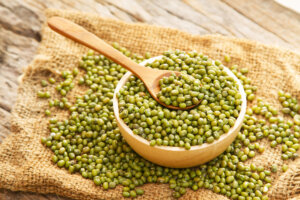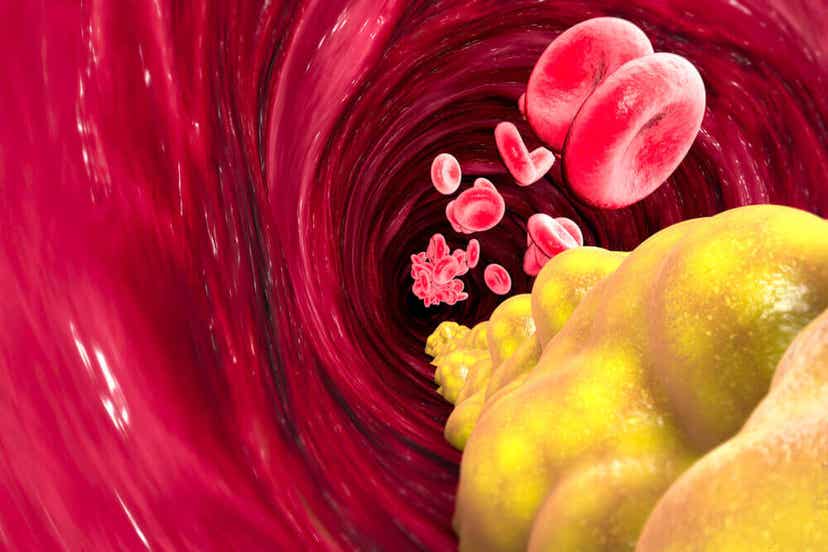Mung Beans: Properties, Uses, and Benefits


Written and verified by the nutritionist Florencia Villafañe
Have you heard about mung beans?
They’re a type of legume that goes by different names. They’re also known as green gram, maash, moong, monggo, or munggo.
However, their scientific name is Vigna radiata and they originate in India, so it’s a typical food in Indian and Asian cuisine. It’s characterized by having a dark green color on the outside and bright yellow inside. In addition, it has a slightly sweet flavor, soft consistency, and freshness similar to that of lentils.
These beans can be used in various dishes. Thanks to its important nutritional value, including them in your diet is an excellent decision.
Nutritional properties of green mung beans
According to one study, we can fin the following nutrient content in 100 grams of this food:
- 20 grams of protein
- 19 grams of carbohydrates
- 7.6 grams of dietary fiber
- Variable vitamin A, C, and B complexes, such as thiamine and riboflavin
- Various minerals, such as magnesium, calcium, iron, and sodium
You may be interested in: Here’s How to Eat Well if You Want to Cut Out Meat
What are the health benefits of mung beans?
Fortunately, all the nutrients they provide help maintain your health. In this sense, the consumption of this legume within a varied, balanced diet and according to each person may offer certain advantages.
According to the Food and Agriculture Organization of the United Nations (FAO), the benefits derived from including legumes in your diet are the following.
Reduces the risk of coronary heart disease
The mung bean’s a food with a remarkable contribution of dietary fiber and can intervene in the reduction of LDL cholesterol, also known as bad cholesterol; a recognized risk factor for heart disease.

They help maintain brain health
The B complex vitamins they provide are necessary for a variety of important bodily functions. Among them, we can mention that they maintain the vitality of neuronal connections and allow optimal brain function, as stated in a study published in the journal Nutrients.
May prevent congenital diseases
In addition to what was mentioned in the previous section, vitamin B9, known as folic acid, has an important role in the development of the fetus during gestation. Specifically, if their intake is adequate, they significantly reduce the risk of congenital anomalies of the neural tube, such as spina bifida, in newborns.
The recommended daily amount of this vitamin is 400 micrograms for adults. However, the value rises to 600 micrograms during the gestation period. Since there are 159 micrograms of folic acid in 100 grams of green mung beans, it could be necessary to resort to supplementation during pregnancy.
The prevention of anemia
The iron content of green mung beans makes them an interesting choice for helping to prevent iron deficiency anemia, which is more common among women and children.
However, it’s important to emphasize that, for the body to take full advantage of this mineral, it’s advisable to combine them with foods containing vitamin C, such as citrus fruits, kiwi, and bell peppers.
They help prevent diabetes
The mung bean, as well as legumes in general, contains virtually no fat and has a remarkable fiber content. In particular, the latter nutrient increases satiety and helps stabilize blood sugar and insulin levels (i.e. they have a low glycemic index). For this reason, they have a preventive effect on weight gain and the onset of diabetes.
They protect the immune system
Apart from nutritional substances, green mung beans have bioactive compounds, such as phytochemicals and antioxidants. In this regard, research suggests that it’s effective in protecting the immune system.
They provide protein in the diet
As they’re a cheaper protein alternative to other foods, such as meats, this grain can be an important protein provider.
It’s also important to mention that those who choose a vegetarian or vegan diet should incorporate legumes daily, in combination with foods such as cereals, seeds, and nuts.
How can mung beans be prepared?
Fortunately, there are different ways to prepare green mung beans, which means that they can be added to different dishes. Let’s see some examples below.
1. Boiled for hot dishes
Like any other legume, they can be boiled until soft. To do this, the beans must be washed, soaked for at least 8 hours, and then boiled (approximately 30 minutes).
Thus, after draining, they can be added to soups, stews, or even processed to make sandwiches or hamburgers.
2. Eat mung beans fresh, for summer days
In Western cultures, fresh green bean sprouts are used as a vegetable to add to salads.
3. As a flour, to prepare dough
In addition to the above, the beans can be ground to form flour. This is useful for preparing products suitable for people with celiac disease, without wheat, oats, barley, or rye, or to vary traditional recipes.
In addition, as green mung beans don’t have a strong flavor, they can also be used to prepare sweet recipes and are useful for adding texture to a meal.

4. As a sprouted food
According to science, sprouted mung beans are a food with greater anti-inflammatory potential than dried beans. With this procedure, the anti-nutritional substances of legumes are eliminated and their nutritional quality is improved.
Specifically, to germinate the mung bean, you need to rinse them, put them in a jar with water, cover them with a cloth, and leave them in a place without any direct light. Then, for 4 or 5 days, change the water and repeat this process until the beans germinate.
Discover: Different Sprouts: Benefits, Risks and Preparation
Mung beans as part of a healthy diet
As you may have noticed, eating mung beans and legumes in general offers a variety of different health benefits. However, eating them should be part of a healthy and balanced eating pattern to avoid nutritional deficiencies.
Therefore, if you’ve never tried them, keep in mind that in addition to their properties, mung beans are easy to prepare and you can add them to many different dishes!
All cited sources were thoroughly reviewed by our team to ensure their quality, reliability, currency, and validity. The bibliography of this article was considered reliable and of academic or scientific accuracy.
- Torres, A., Cova, A., & Valera, D. (2018). Efecto del proceso de germinación de granos de Cajanuscajan en la composición nutricional, ácidos grasos, antioxidantes y bioaccesibilidad mineral. Revista chilena de nutrición, 45(4), 323-330.
- Páez Martínez, C. A., & Rodríguez García, J. S. (2020). Evaluación del crecimiento del frijol mungo (Vigna radiata) bajo aplicación de fósforo y bioestimulante en El Espinal-Tolima.
- Beneficios nutricionales de las legumbres. Organización de las Naciones Unidas para la alimentación y la Agricultura (FAO). Disponible en: http://www.fao.org/3/i5384s/i5384s.pdf
- Tang, D., Dong, Y., Ren, H., Li, L., & He, C. (2014). A review of phytochemistry, metabolite changes, and medicinal uses of the common food mung bean and its sprouts (Vigna radiata). Chemistry Central Journal, 8(1), 1-9.
- Pérez Rubio, M. D. R. (2011). Evaluación de la composición nutricional y digestibilidad aparente e ileal en porcinos del frijol mungo (Vigna radiata o Phaseolus aureus) con y sin tratamiento térmico. Maestría Ciencias Agrarias.
- Guerrero Wyss, L., & Durán-Agüero, S. (2020). Consumo de legumbres y su relación con enfermedades crónicas no transmisibles. Revista chilena de nutrición, 47(5), 865-869.
- Kennedy, D. O. (2016). B vitamins and the brain: mechanisms, dose and efficacy—a review. Nutrients, 8(2), 68.
This text is provided for informational purposes only and does not replace consultation with a professional. If in doubt, consult your specialist.








